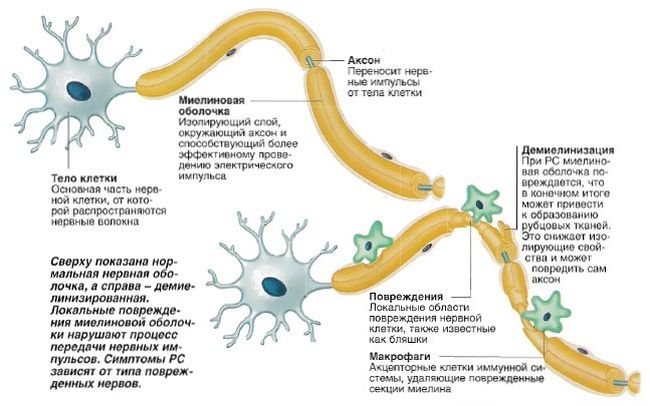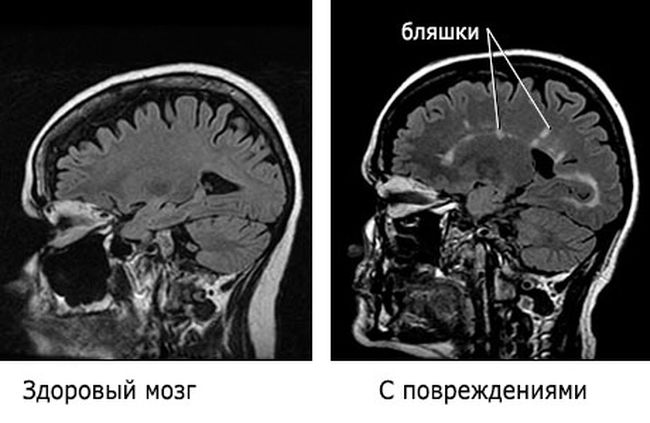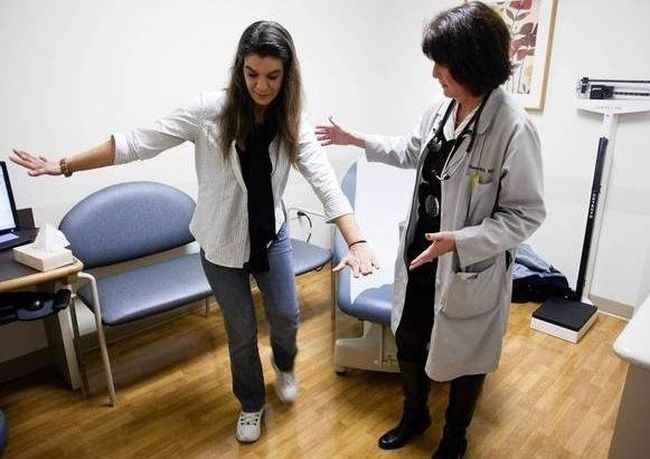Multiple sclerosis is a chronic common disease that affects the spinal cord and brain. It is caused by a malfunction of the human immune system, which destroys the neurons in the brain and replaces them with connective (cicatricial) tissue. Because of this, the transmission of the nerve impulse is disrupted.
Multiple sclerosis is often confused with senile sclerosis, but these are different diseases. All they have in common is the presence of scar tissue, which replaces neurons. The lesions are scattered throughout the body, so the disease has a wide range of symptoms.
Most often, young people from 15 to 40 years old suffer from multiple sclerosis, and after 40 the likelihood of getting sick decreases markedly. There are cases when multiple sclerosis was recorded in children from two years of age.
It is noteworthy that this disease often affects Europeans, and Asians rarely get sick with it. At the same time, residents of megalopolises are more likely to be diagnosed with such a diagnosis than people from suburbs and villages. Residents of equatorial countries practically do not suffer from multiple sclerosis, and the population of northern countries accounts for 70 cases of the disease out of 100. The conclusion suggests itself that the appearance of sclerosis is influenced by a person's lifestyle. It has also been noticed that wives suffer from multiple sclerosis several times more often than men. Rrrs news reports that cases of the disease have become more frequent lately.
Causes of the disease
The center of multiple sclerosis is in the brain. In a healthy person, the spinal cord and brain are covered with a blood-brain barrier, which reliably protects the brain from the penetration of blood cells and various microorganisms into it. In people with multiple sclerosis, lymphocytes, immune cells designed to fight infection, penetrate the barrier. But they begin to attack the brain cells, destroying their membrane. At the site of destruction, inflammation occurs, which is then replaced by connective tissue. A "scar" is formed, which becomes non-functional and disrupts the transmission of impulses from the brain to the body. As a result, a person's speech may be impaired, sensitivity decreases, and body control becomes difficult.
Medicine has not yet given an exact answer to the question of what causes multiple sclerosis. But there are factors that can contribute to the appearance of the disease:
- strong and prolonged stress;
- bacterial and viral diseases;
- genetic addiction (the presence of altered genes);
- vitamin D deficiency;
- trauma;
- bad ecological situation;
- eating disorder.
There are also versions that vaccination against hepatitis B and the measles virus can cause multiple sclerosis, but they have not been confirmed.

Multiple sclerosis forms
- Recurrent. It occurs most often and is a series of exacerbations and remissions.
- Recurrent progressive. It is similar to the previous form, but during each exacerbation, irreparable disturbances in the work of the brain occur, therefore each subsequent remission is burdened with new symptoms.
- Primarily progressive. The disease begins sluggishly, has mild symptoms, and develops very slowly for some time. But then it quickly gains momentum and in a few years leads a person to disability.
- Secondary progressive. For several years, the disease develops very slowly, but after the first exacerbation, it begins to progress rapidly and causes irreversible disorders of the nervous system.
- Clinically isolated. This form is diagnosed as soon as the patient was diagnosed with multiple sclerosis. What form the disease will take then becomes known after the first exacerbation.
Symptoms
This disease is characterized by a very long latency period, which can last from several weeks to several years. The functions of the brain cells affected by the immune system are quickly taken over by neighboring cells, and the damage is not noticeable. The first signs of multiple sclerosis become visible only when the immune system has damaged about 40 percent of the neurons. The formed plaques can be clearly seen in the photo:
The earliest symptoms are:
- changes in body temperature, a person is thrown into heat, then into cold;
- weakness of the legs, slight numbness, feeling of tiredness. In rare cases, the same symptom is observed in the hands;
- pronounced emotional instability and frequent, abrupt mood swings;
- periodic slight numbness of the extremities, "goose bumps" on the body;
- having vision problems. Most often, there is a decrease in vision in one eye;
- there are pulling pains in the lower back or abdomen;
- paresis of the facial nerve;
- delay in urination or frequent urge to urinate;
- severe dizziness, which is often accompanied by nausea. Vomiting is possible.

If the disease has already passed to the next stage, then its symptoms are as follows:
- trembling limbs, unsteady gait, unsteady movements;
- narrowing of the field of vision, general deterioration of vision;
- extreme emotional instability, euphoria and depression often replace each other;
- disruption of the pelvic organs, possibly incontinence. Men develop impotence;
- behavior becomes inhibited and mental activity becomes difficult. It is very difficult to concentrate attention on something;
- decreased muscle tone, paresis;
- change in sensitivity, numbness, pain, indications occur;
- speech slows down.
It is noteworthy that there is no symptom that would definitely indicate that the patient has multiple sclerosis. With a combination of signs, the doctor makes a diagnosis and carries out additional diagnostics.
Diagnostics
Since multiple sclerosis is diagnosed already when many brain cells have already died, it is necessary to identify the disease as soon as possible. You need to see a doctor when at least 2 symptoms from the above list appear and last more than a day. Especially if it happened more than once.
If you suspect multiple sclerosis, a person is made a brain, which allows you to identify plaques in the brain that were formed by connective tissue.
It is noteworthy that multiple sclerosis in children under 10 has better prognosis in adults and adolescents.
It is a mistake to think that multiple sclerosis is curable; in some cases, the right treatment can completely stop the progress of the disease, so you need to see a doctor as soon as possible.
Treatment
At the moment, there are no drugs that can completely cure this disease. Stem cell-based products are under development that can restore dead brain cells, neural connections and related body functions. But this remedy will be available in 10-15 years, and now the treatment is to try to stop the disease and make the symptoms less noticeable.
If the symptoms have just appeared, then the person is recommended to completely switch to a healthy lifestyle, avoid allergens and undergo physical therapy procedures to reduce the manifestation of symptoms. This often succeeds, since the disease stops destroying the body, and the function of the destroyed cells is taken over by other neurons as far as possible. It is very important for the patient not to stop physiotherapy even during the period of remission, go for a massage, etc., otherwise an aggravation is possible.
In advanced or progressive cases, the patient is prescribed anti-inflammatory drugs and drugs that suppress the immune system. It helps to slow down the destruction of the brain, although it negatively affects the overall health of the body.

In many ways, it all depends on the course of the disease. Someone for many years does not know about their multiple sclerosis, and then, having chosen the treatment, they live happily and for a long time, and someone becomes disabled in a few years. There is no guarantee that treatment will lead to a fulfilling life, but it does increase the chances of it. There are no statistics on how long people with multiple sclerosis live, but there is no evidence that they die earlier than others. There are reviews about alternative methods of treatment, but they all need to be agreed with the doctor.
Important! If some clinic offers a complete cure for multiple sclerosis, then you need to know that there are scammers in front of you.
Treatment with folk remedies
As mentioned above, multiple sclerosis is considered an incurable disease, the development of which can be stopped or slowed down.
There is no remedy that will 100% protect against multiple sclerosis, but there are those who will significantly reduce the risk of getting it. But with the right treatment, there is a chance to live to a ripe old age. Traditional medicine offers several harmless options that can improve the patient's condition.
Honey and onions. On a grater, you need to rub the onion and squeeze the juice out of it (you can use a juicer). A glass of juice must be mixed with a glass of natural honey. This mixture should be taken three times a day one hour before meals.
Blackcurrant juice. An excellent natural remedy to help get rid of. You need to drink it three times a day for a third of a glass. Can be replaced with fresh berries.
Mumiyo. For treatment, it is necessary to dissolve 5 g of the mummy in half a glass of water and take a teaspoon before meals three times a day. Store the product in the refrigerator.
Garlic oil. In order to cook it, you need to take a head of garlic and crush it into a gruel, and then pour a glass of sunflower oil. You need to choose unrefined and non-deodorized oil. After the remedy has been infused for several days, it is taken three times a day, a teaspoon half an hour before meals.
Prevention of multiple sclerosis
- Constant physical activity is required. They should be moderate, not debilitating.
- If possible, you need to avoid stress, find time to relax. A hobby will help you distract yourself from thinking about problems.
- Cigarettes and alcohol accelerate neuronal destruction and can impair the immune system.
- Keeping track of your weight, refusal of rigid diets and overeating.
- Refusal of hormonal medications (if possible) and contraceptives.
- Refusal of large amounts of fatty foods;
- Avoid overheating.
Multiple sclerosis Is an incurable disease that can lead to disability, but this is not a sentence. It is important to diagnose the disease on time and follow all the doctor's prescriptions. Then a person has a chance to live to old age and maintain good spirits.

